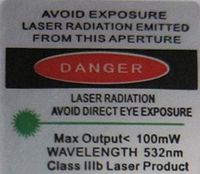Even the first laser was recognized as being potentially dangerous. Theodore Maiman characterized the first laser as having a power of one "Gillette" as it could burn through one Gillette razor blade. Today, it is accepted that even low-power lasers with only a few milliwatts of output power can be hazardous to human eyesight when the beam hits the eye directly or after reflection from a shiny surface. At wavelengths which the cornea and the lens can focus well, the coherence and low divergence of laser light means that it can be focused by the eye into an extremely small spot on the retina, resulting in localized burning and permanent damage in seconds or even less time.
Lasers are usually labeled with a safety class number, which identifies how dangerous the laser is:
Class 1 is inherently safe, usually because the light is contained in an enclosure, for example in CD players.
Class 2 is safe during normal use; the blink reflex of the eye will prevent damage. Usually up to 1 mW power, for example laser pointers.
Class 3R (formerly IIIa) lasers are usually up to 5 mW and involve a small risk of eye damage within the time of the blink reflex. Staring into such a beam for several seconds is likely to cause damage to a spot on the retina.
Class 3B can cause immediate eye damage upon exposure.
Class 4 lasers can burn skin, and in some cases, even scattered light can cause eye and/or skin damage. Many industrial and scientific lasers are in this class.
The indicated powers are for visible-light, continuous-wave lasers. For pulsed lasers and invisible wavelengths, other power limits apply. People working with class 3B and class 4 lasers can protect their eyes with safety goggles which are designed to absorb light of a particular wavelength.
Infrared lasers with wavelengths beyond about 1.4 micrometres are often referred to as "eye-safe", because the cornea strongly absorbs light at these wavelengths, protecting the retina from damage. The label "eye-safe" can be misleading, however, as it only applies to relatively low power continuous wave beams; a high power or Q-switched laser at these wavelengths can burn the cornea, causing severe eye damage, and even moderate power lasers can injure the eye.










